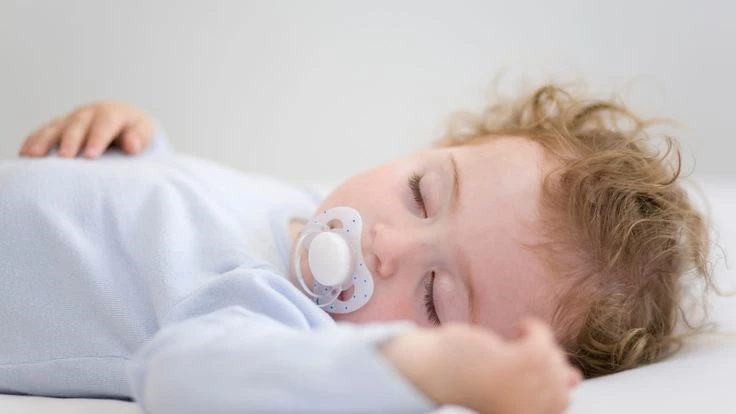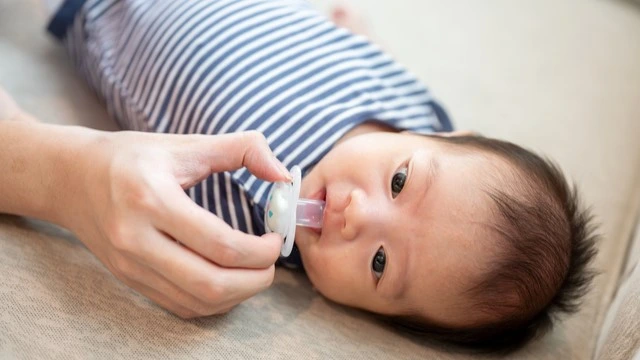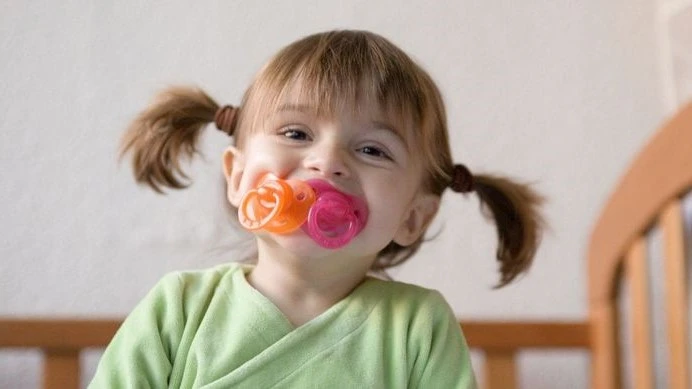Did you know that using a pacifier during sleep can reduce the risk of SIDS by up to 90% when combined with safe sleep practices? That’s not just a comforting thought—it’s a powerful reason many parents turn to these tiny tools.
As a mom myself, I remember the relief of seeing my baby settle down with a pacifier, giving us both a moment of peace. Pacifiers are more than just a way to soothe a fussy newborn; they can support better sleep, emotional regulation, and even developmental milestones for preemies. But like anything in parenting, it’s not all smooth sailing! From dental health to potential dependency, there’s a lot to unpack.
In this blog, I’m diving into the benefits, risks, and expert-backed tips to help you decide if pacifiers are the right choice for your little one or Can a newborn sleep with a pacifier? Let’s explore the real scoop—no fluff, just facts and a bit of heart. 💛
Benefits of Pacifiers
Pacifiers offer more than just a way to calm your newborn. Here’s an expanded list of benefits, backed by research and expert insights:
Reduces the Risk of Sudden Infant Death Syndrome (SIDS)
Studies have shown pacifiers can reduce the risk of SIDS, making them a potentially lifesaving tool. According to the Centers for Disease Control and Prevention (CDC), SIDS rates have decreased significantly with the promotion of safe sleep practices, including pacifier use.
“Using a pacifier at sleep times provides a simple but effective layer of protection against SIDS,” says Dr. Lisa Thompson, a leading pediatric sleep researcher.
Fact: A large-scale study published in The Lancet found that pacifiers reduced the risk of SIDS by up to 90% when combined with other safe sleep practices.
Provides Comfort and Soothing
Babies have a natural sucking reflex, and pacifiers fulfill this need when they’re fussy, overtired, or stressed. Many parents report that pacifiers help during late-night wake-ups or public outings when quick calming is needed.

Sleep Improvement
Using a pacifier can help your baby settle faster and sleep more soundly, which can be a lifesaver for sleep-deprived parents. Consistent use during naps and bedtime can create a soothing bedtime routine.
Introducing a pacifier can be a helpful tool in establishing a calming bedtime routine. For parents exploring gentle sleep training methods, the Chair Method offers an approach that complements pacifier use by promoting self-soothing skills. Learn more about this technique in our guide on Chair Method Sleep Training
Pain Relief During Stressful Situations
Research has shown that sucking on a pacifier releases endorphins, which act as natural pain relievers. This is especially helpful during vaccinations, blood tests, or teething.
Promotes Oral Development in Preemies
Premature babies in NICUs often benefit from pacifiers, as the sucking motion encourages oral muscle development and improves feeding readiness. Studies suggest that pacifiers also help stabilize heart rate and breathing in preterm infants.
Accessibility
Pacifiers are inexpensive, portable, and available almost anywhere—a lifesaver for parents looking for an instant calming solution.
“For preemies, pacifiers can mean the difference between a struggling start and a smoother transition to bottle or breastfeeding,” says Dr. Amy Harper, a neonatal specialist.

Psychological Benefits of Pacifiers
- Self-Soothing Skills: Pacifiers can be an early tool in teaching your baby to self-soothe, which is a foundational skill for managing emotions as they grow.
- Separation Anxiety Relief: As babies develop, pacifiers can serve as a comfort object, helping them cope with separation anxiety during naps or bedtime.
- Calming Sensory Stimulation: Sucking on a pacifier provides a gentle sensory input that can help babies regulate their nervous systems, especially in overstimulating environments.
Potential Risks of Pacifiers
While pacifiers can be beneficial, they’re not without risks. Here’s a closer look at the downsides and ways to mitigate them:
Dependency
Babies can grow reliant on pacifiers for self-soothing, which may make nighttime weaning challenging. Experts recommend gradually limiting pacifier use to avoid dependency issues.
Dental Issues
Prolonged pacifier use beyond age two may lead to dental problems, such as crooked teeth or bite misalignment. According to the American Dental Association (ADA), pacifier use after age four can cause long-term dental changes, including an open bite or overjet.
Fact: Early weaning from pacifiers significantly reduces the risk of dental issues.
Increased Risk of Ear Infections
Pacifiers have been linked to a slightly higher risk of middle ear infections, particularly in older babies. Limiting use to sleep times and practicing proper hygiene can minimize this risk.
Quick Fact: A 2018 study in Acta Paediatrica found that proper pacifier cleaning habits significantly reduce the risk of infections in babies.

When Can My Newborn Start Using a Pacifier?
Timing is everything when introducing a pacifier. For breastfed babies, waiting until breastfeeding is well-established, usually around 3 to 4 weeks, is ideal. This ensures your baby develops a strong latch and minimizes the risk of nipple confusion. Introducing a pacifier too soon might make breastfeeding routines challenging.
For bottle-fed babies, pacifiers can be introduced right away without much worry. Since there’s no concern about nipple confusion, many parents use pacifiers as a quick and effective way to soothe their baby. They’re especially helpful during fussy moments or bottle transitions.
Premature babies often benefit from pacifiers even earlier, as they help develop sucking reflexes and improve feeding readiness. In NICUs, pacifiers are used to calm preemies and stabilize their breathing. Always consult your pediatrician for advice tailored to your baby’s unique needs.
Expert Insight: “Premature babies who use pacifiers show faster weight gain and better feeding readiness,” notes Dr. Rachel Gomez, a neonatologist.
Additionally, always consult your pediatrician about the best time to introduce a pacifier, as individual factors like weight, feeding routines, and health conditions can influence the decision.
Tips and Tricks for Getting Your Baby to Take a Pacifier
Introducing a pacifier doesn’t always go smoothly. Here are practical tips to ease the process:
- Choose the Right Pacifier: Experiment with different shapes, sizes, and materials to find one that suits your baby. Some babies prefer silicone, while others like latex.
- Timing Is Everything: Offer the pacifier when your baby is calm or slightly fussy—not when they’re already crying hard.
- Add Familiarity: Dipping the pacifier in breast milk or formula can make it more appealing to your baby.
- Consistency Matters: Use the pacifier at predictable times, such as naps and bedtime, to help your baby associate it with comfort.
- Stay Patient: If your baby refuses the pacifier initially, try again later. Persistence is key.
FAQs about Can a Newborn Sleep with a Pacifier
Yes, introducing a pacifier too early (before breastfeeding is well-established) can sometimes lead to nipple confusion, making it harder for the baby to latch properly. Experts recommend waiting until your baby is 3-4 weeks old and nursing effectively before introducing a pacifier.
To maintain hygiene, wash pacifiers daily with warm, soapy water or sterilize them in boiling water for a few minutes. Avoid cleaning a pacifier by putting it in your mouth, as this can transfer bacteria to your baby.
If your baby starts relying too heavily on a pacifier, try gradually reducing its use by limiting it to specific times, like naps or bedtime. Offer alternative soothing methods, such as cuddling, rocking, or a favorite toy.
Wrapping It Up
So, can a newborn sleep with a pacifier? Absolutely, as long as it’s used safely and appropriately. Pacifiers can offer comfort, reduce the risk of SIDS, and help your baby sleep better. However, it’s important to be mindful of the risks and follow expert guidelines to ensure your baby’s safety.
By weighing the benefits and potential drawbacks, you can make an informed decision that works best for your family. And remember, every baby is different—what works for one might not work for another.
Parenthood is a journey of learning and adapting. If pacifiers bring peace to your family, embrace them as a helpful tool. If they don’t, trust your instincts and explore other methods to soothe and support your baby.
Do you have questions about pacifiers or other parenting concerns? Drop them in the comments below, and let’s navigate this journey together!









